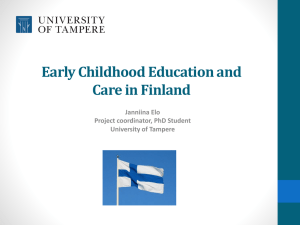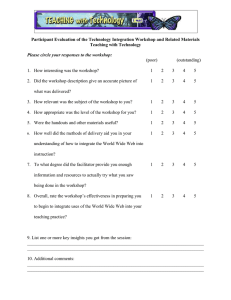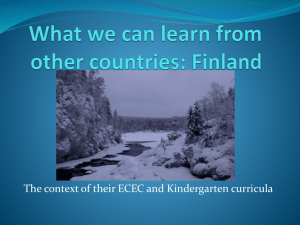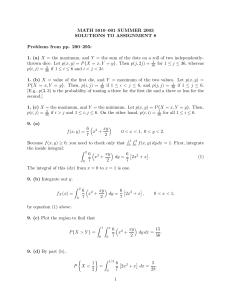Item 4: Overview of country responses on “Integration of Early Childhood
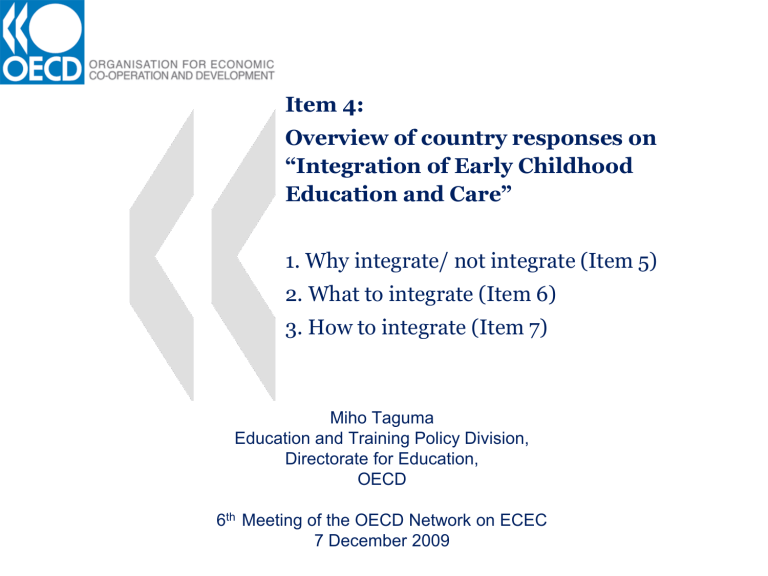
Item 4:
Overview of country responses on
“Integration of Early Childhood
Education and Care”
1. Why integrate/ not integrate (Item 5)
2. What to integrate (Item 6)
3. How to integrate (Item 7)
Miho Taguma
Education and Training Policy Division,
Directorate for Education,
OECD
6 th Meeting of the OECD Network on ECEC
7 December 2009
2. Overview of country responses
Integrated system
Chile (EDU)
Split system
Belgium - Flanders
Finland (SOC for 0-6; EDU for 6+) Belgium - French Community
New Zealand (EDU) Czech Republic
Norway (EDU) Hungary
Scotland - U.K. (EDU)
Slovenia (EDU)
Sweden (EDU)
Ireland
Italy
Japan
Mexico
Portugal
Turkey
Other system
Australia (Federal - States and Territories)
Canada (Federal – Provinces and Territories)
1. Why integration/ not integrate?
Why integration? Why non-integration?
Politics, public opinions
Policy goals
System management
Funding
Curriculum and pedagogy
Politics, history, values, and administration
But some countries are moving towards integration….
Policy goals
System management
Funding
Under the integrated system…
2. What to integrate
Target Components
Policy, policy goals
CHL FIN NZL
Done Done Done
NOR
Done
Administration
Legal framework and regulations (teachers, buildings, hours, etc.)
Done Done
Done Done
Done
Done
Done
Done
SCO
Done
Done
Done
SLN SWE
Done Done
Done Done
Done Done
Funding
Curriculum and pedagogy
Done Done
Done Done
Done
Done
Done
Done
Done
Done
Done Done
Done Done
Quality assurance (Inspections, monitoring, etc.)
Teacher salaries
Fees for parents
Teacher qualifications; Teacher education and training
Delivery of services; joint location; age; staff / child ratio, etc.
Others
Done Done
Done Done
Done Done
Done Done
Done Done
N/A N/A
Done
Done
Done
No plan
No plan
N/A
Done Done Done Done
Done Done Done Done
Done Intended Done Done
Done Done Done Done
Done Intended Done Done
N/A N/A N/A N/A
Under the split system and other systems…
* administration; framework; delivery (programme, access points, opening hours, etc.); primary and kindergarten teachers; national curriculum)
3. How to integrate?
Effective implementation would require…
Political commitment
Stakeholder buy-in
Adequate funding
Coherence for children/parents local needs
Realistic time frame
For affordable and equal access to quality ECEC, integration of …
Governance, administration, funding
• Consultation/meetings
• Inter-ministerial memorandum of understanding
• Appoint a lead ministry at the national level
• Delegate/ ensure integration at the local level with a nationally developed framework
• Set up a cross-ministerial unit in the cabinet office
• Merge/ restructure ministry of education and ministry of labor and social affairs
• Earmark funding on ECEC
(creating places, improving quality, etc.)
• etc…
Policy, goals, legislation, regulations
• Set a national clear vision/ strategy for 0-6 or 0-8
• Design a national framework / standards for ECEC
• Sett out a national quality agenda
• Reconcile policy goals between labour market policy, education policy and social policy
• etc….
Quality assurance
• While respecting local authorities, put in a national quality accreditation system
• Put in place continuous selfevaluation
• Mainstream external evaluation
• Develop standards for different ECEC programmes/agenda
• Establish better cooperation in data collection
• Better monitoring for national reporting
• Setting up a national quality rating systems
• etc…
Delivery, qualifications, salaries
• Create more places with iminimum standards
• Transform ECEC institutions / centres into self-governing body to meet local needs
• Develop a model where different stakeholders coordinate/ cooperate
• Create one location for children and parents where they can access all the educational, care, sports and cultural activities
• Share rules for operations (e.g. opening hours, programmes)
• Identify local needs
• Engage parent and community to plan the delivery service and increase participation Provide joint training courses for staff in ECEC
Unify
• etc…
Curriculum and pedagogy
• Develop a national curriculum with clear goals
• Develop more detailed, outcomes-based curriculum
• Integrate more learning into care centres without losing non-cognitive child development
• Develop a coherent curriculum with compulsory schooling
• Organise public debates and develop curriculum based on needs/ stakeholder buy-in
• Develop curriculum by learning from other countries
• Set up a national commission to advise on pedagogies
• etc….
Fees for parents
• Set a ceiling/ cap for ECEC
• Make free universal access
• Subsidise for low-income families
• Provide vouchers – either universal or targeted
• Make part of ECEC compulsory/ lower the age of compulsory schooling,
• etc…
Questions for Discussion
Item 5: Why integrate/not integrate?
– What does ‘integration/non-integration of ECEC’ mean for child and parents? For ECEC managers and staff? For researchers?
For local governments? (vs national governments)
– Who will benefit from it? Who will face difficulties?
Item 6: What to integrate?
– How can countries manage the cost of policies for integration?
– Is there an effective alignment order e.g. curriculum before qualifications?
Item 7 How to integrate?
– What are the major challenges and constraints in implementing integration initiatives? What works / doesn’t work?
– If it works, under what conditions?
– If not, what alternatives are available?
